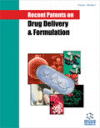- Home
- A-Z Publications
- Recent Patents on Drug Delivery & Formulation
- Previous Issues
- Volume 8, Issue 3, 2014
Recent Patents on Drug Delivery & Formulation - Volume 8, Issue 3, 2014
Volume 8, Issue 3, 2014
-
-
Oxidative Damage Impact on Aging and Age-Related Diseases: Drug Targeting of Telomere Attrition and Dynamic Telomerase Activity Flirting with Imidazole-Containing Dipeptides
More LessAuthors: Mark A. Babizhayev, Khava S. Vishnyakova and Yegor E. YegorovIt has been documented that telomere-associated cellular senescence may contribute to certain age-related disorders, including an increase in cancer incidence, wrinkling and diminished skin elasticity, atherosclerosis, osteoporosis, weight loss, age-related cataract, glaucoma and others. Shorter telomere length in leukocytes was associated crosssectionally with cardiovascular disorders and their risk factors, including puls Read More
-
-
-
Recent Patents on Ophthalmic Nanoformulations and Therapeutic Implications
More LessNanoformulations (NF) are widely explored as potential alternatives for traditional ophthalmic formulation approaches. The effective treatment of ocular diseases using conventional eye drops is often hampered by factors such as: physiological barriers, rapid elimination, protein binding, and enzymatic drug degradation. Combined, these factors are known to contribute to reduced ocular residence time and poor bioavailability. Read More
-
-
-
Recent Patents on Oral Insulin Delivery
More LessAuthors: Somnath D. Navgire, Amit S. Satpute, Suneel Pandey and Arun T. PatilOral administration of Insulin, however, is extremely difficult due to its extremely low bioavailability. Development of oral Insulin formulations requires overcoming obstacles, such as low permeability of large molecules, lack of lipophilicity, and inactivation or rapid enzymatic degradation in the gastrointestinal (GI) tract. The successful oral delivery of Insulin involves overcoming the barrier of enzymatic degradation, achievin Read More
-
-
-
Patent Perspectives for Corticosteroids Based Ophthalmic Therapeutics
More LessAuthors: Preeti K. Suresh and Abhishek K. SahEye inflammation, if untreated at right time poses the risk of vision loss. Several categories of drugs are available in the global market, but corticosteroids are still used for the treatment of ocular inflammation including anterior/ posterior uveitis, age related macular degeneration (AMD) and post cataract surgery inflammation. Although corticosteroids have well-documented side effects as compared to non steroidal anti-i Read More
-
-
-
New Mucoadhesive Polymeric Film for Ophthalmic Administration of Acetazolamide
More LessAuthors: Luis I. Tartara, Santiago D. Palma, Daniel Allemandi, Maria I. Ahumada and Juan M. LlabotThis article reports the results concerning the design and manufacture of a novel polymeric film for ocular administration of acetazolamide (AZM), and a patent document presented to INPI- National Institute of Industrial/Intelectual Property. The system was designed using mucoadhesive polymers, such as carbomer (CB974P) and sodium carboxymethylcellulose (NaCMC), combined with the poloxamer (POL407) which beh Read More
-
-
-
Recent Patents Survey on Self Emulsifying Drug Delivery System
More LessAuthors: Sahilhusen I. Jethara, Alpesh D. Patel and Mukesh R. PatelSelf-Emulsifying Drug Delivery System is a unique feasible approach to overcome low oral bioavailability problem which is associated with the hydrophobic drugs due to their unparalleled potential as a drug delivery with the broad range of application. The estimated 40% of active pharmaceuticals are poorly water soluble. Now recently, formulation containing oral SEDDS has received much interest as it solve probl Read More
-
Most Read This Month
Article
content/journals/ddf
Journal
10
5
false
en


